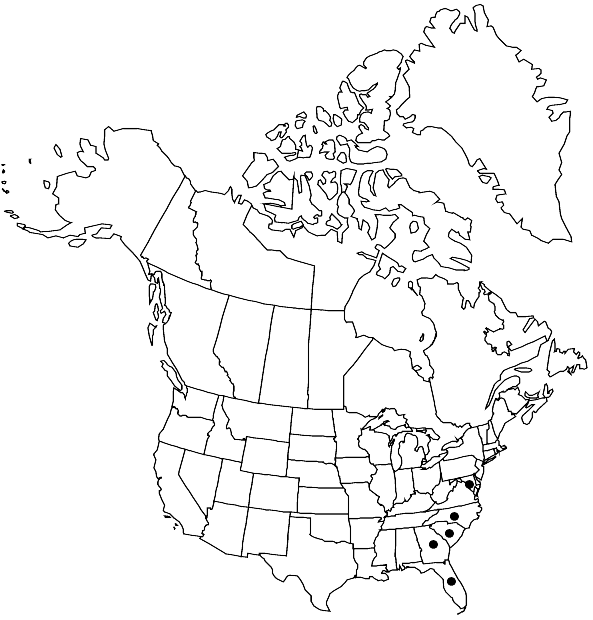Difference between revisions of "Sphagnum cribrosum"
Eur. Hvitmoss., 74. 1882,.
Synonyms: Sphagnum floridanum (Austin) Cardot Sphagnum macrophyllum var. floridanum Austin
FNA>Volume Importer |
imported>Volume Importer |
||
| (6 intermediate revisions by 2 users not shown) | |||
| Line 10: | Line 10: | ||
|name=Sphagnum floridanum | |name=Sphagnum floridanum | ||
|authority=(Austin) Cardot | |authority=(Austin) Cardot | ||
| − | }}{{Treatment/ID/Synonym | + | |rank=species |
| + | }} {{Treatment/ID/Synonym | ||
|name=Sphagnum macrophyllum var. floridanum | |name=Sphagnum macrophyllum var. floridanum | ||
|authority=Austin | |authority=Austin | ||
| + | |rank=variety | ||
}} | }} | ||
|hierarchy=Sphagnaceae;Sphagnum;Sphagnum sect. Isocladus;Sphagnum cribrosum | |hierarchy=Sphagnaceae;Sphagnum;Sphagnum sect. Isocladus;Sphagnum cribrosum | ||
| Line 27: | Line 29: | ||
|elevation=low elevations | |elevation=low elevations | ||
|distribution=Fla.;Ga.;Md.;N.C.;S.C. | |distribution=Fla.;Ga.;Md.;N.C.;S.C. | ||
| − | |discussion=<p>Besides having different branch leaf porosity, Sphagnum cribrosum is usually distinguishable from the closely related S. macrophyllum by its paler brown color and distinctly broader and more truncate branch leaves. “Wave forms” of both S. cribrosum and S. macrophyllum, seemingly developed in response to growing in shallow water where wave action is common, can have very odd phenotypes that may look more like Fontinalis than Sphagnum.</p> | + | |discussion=<p>Besides having different branch leaf porosity, <i>Sphagnum cribrosum</i> is usually distinguishable from the closely related <i>S. macrophyllum</i> by its paler brown color and distinctly broader and more truncate branch leaves. “Wave forms” of both <i>S. cribrosum</i> and <i>S. macrophyllum</i>, seemingly developed in response to growing in shallow water where wave action is common, can have very odd phenotypes that may look more like <i>Fontinalis</i> than <i>Sphagnum</i>.</p> |
|tables= | |tables= | ||
|references= | |references= | ||
| Line 36: | Line 38: | ||
-->{{#Taxon: | -->{{#Taxon: | ||
name=Sphagnum cribrosum | name=Sphagnum cribrosum | ||
| − | |||
|authority=Lindberg | |authority=Lindberg | ||
|rank=species | |rank=species | ||
| Line 50: | Line 51: | ||
|publication year= | |publication year= | ||
|special status= | |special status= | ||
| − | |source xml=https:// | + | |source xml=https://bitbucket.org/aafc-mbb/fna-data-curation/src/2e0870ddd59836b60bcf96646a41e87ea5a5943a/coarse_grained_fna_xml/V27/V27_31.xml |
|genus=Sphagnum | |genus=Sphagnum | ||
|section=Sphagnum sect. Isocladus | |section=Sphagnum sect. Isocladus | ||
Latest revision as of 21:25, 5 November 2020
Plants green, light brown to brown. Branch leaves ovate-ligulate, apex broad, rounded, and truncate, hyaline cells with 20–40 small (less than 0.25 cell diameter) in mostly 2 rows.
Habitat: Floating or stranded at margins of shallow acidic lakes and ponds
Elevation: low elevations
Distribution

Fla., Ga., Md., N.C., S.C.
Discussion
Besides having different branch leaf porosity, Sphagnum cribrosum is usually distinguishable from the closely related S. macrophyllum by its paler brown color and distinctly broader and more truncate branch leaves. “Wave forms” of both S. cribrosum and S. macrophyllum, seemingly developed in response to growing in shallow water where wave action is common, can have very odd phenotypes that may look more like Fontinalis than Sphagnum.
Selected References
None.
Lower Taxa
None.